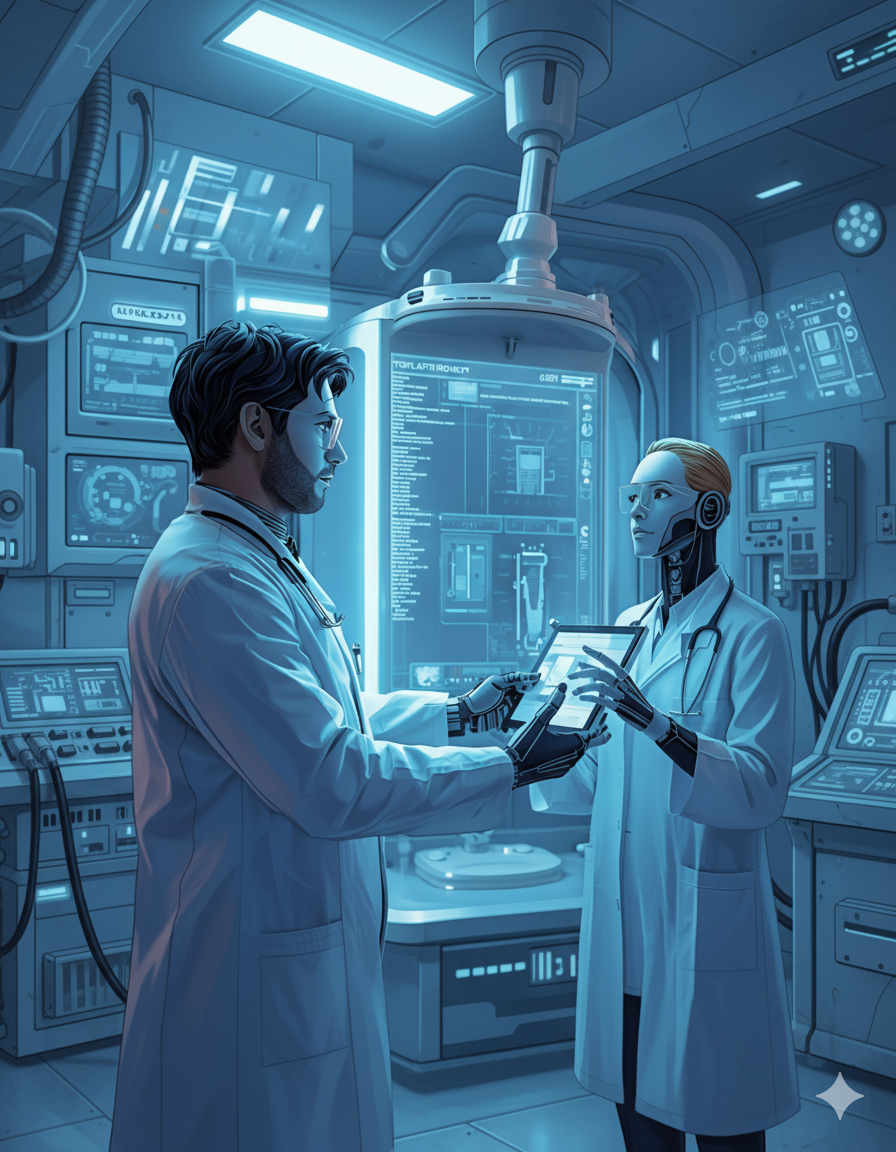Ambient AI Scribes in the Real World: 12 Common Failures and How Human-AI Hybrids Solve Them

Ambient AI Scribes: 12 Common Failures and How Human-AI Hybrids Fix Them
In recent years, AI medical scribes have emerged as a promising solution to one of healthcare’s most persistent challenges—clinical documentation overload. Hospitals, clinics, and private practices are increasingly adopting ambient AI scribe technologies to capture patient encounters automatically, aiming to save physicians from the repetitive task of typing notes into the electronic health record (EHR). While this innovation promises speed and convenience, real-world results show that it’s far from perfect. When left entirely to automation, AI documentation tools can introduce subtle—but serious—errors that affect accuracy, compliance, and even patient safety.
The reality is that AI medical scribes often struggle with the nuances of clinical language, medical context, and conversational detail. Background noise, overlapping speech, or varied accents can lead to transcription errors or incomplete notes. Without human oversight, these lapses can result in documentation inconsistencies that physicians must later correct—adding back the very administrative burden these tools were meant to eliminate.
That’s why many healthcare organizations are now shifting toward human-AI hybrid scribing models—a balanced approach that blends the speed of AI-powered transcription with the accuracy and judgment of trained virtual scribes. In this system, AI scribes perform the initial note generation, while human medical scribes review, verify, and refine the output in real time. This collaboration not only ensures that each patient encounter is accurately captured but also preserves the clinical context essential for quality care and compliance.
In practice, a purely AI-driven scribe system might misinterpret similar-sounding medical terms, miss critical qualifiers, or fail to distinguish between patient-reported symptoms and physician observations. These failure modes can lead to flawed medical notes, incorrect billing codes, and time-consuming rework. In contrast, a hybrid model provides the safeguard of human validation—where a professional virtual medical scribe ensures that every diagnosis, medication, and assessment is correctly transcribed and contextually sound.
As healthcare continues to embrace automation, understanding the limitations of ambient AI scribes becomes increasingly important. This blog explores 12 real-world failure modes seen in AI-only documentation systems and how a human-AI hybrid scribing model effectively prevents them. Whether you’re a physician, clinic manager, or healthcare administrator, recognizing these gaps is key to adopting technology that truly supports your workflow—without compromising accuracy, compliance, or patient trust.
The future of clinical documentation isn’t purely human or purely artificial—it’s collaborative. The combination of AI medical scribes and skilled human scribes represents a practical evolution: smarter, faster, and more reliable documentation that lets providers focus on what matters most—patient care.
The Promise of Ambient AI Scribes
The growing interest in ambient AI scribes reflects healthcare’s ongoing pursuit of smarter, faster, and more human-centered documentation solutions. Traditional medical scribes have long helped physicians reduce the burden of note-taking, but the next evolution—AI medical scribes—takes automation to a new level. These systems use natural language processing (NLP), speech recognition, and machine learning to listen to patient-provider conversations and generate structured clinical notes automatically within the EHR.
The promise of AI medical scribes lies in their ability to work silently in the background—capturing every spoken detail, recognizing medical terminology, and summarizing encounters in real time. For healthcare providers, this means less time typing and more time focusing on patients. Clinics adopting AI scribe technology report improvements in documentation turnaround time, reduced after-hours charting, and noticeable relief from EHR fatigue. When implemented effectively, ambient AI can help physicians reclaim hours each week—time they can reinvest in patient care, research, or simply achieving better work-life balance.
Beyond efficiency, AI medical scribes also bring scalability. A single AI-powered scribe platform can support hundreds of physicians simultaneously, unlike traditional virtual scribes who must handle cases individually. For growing healthcare systems, this scalability helps streamline operations while maintaining consistency in documentation quality and structure.
Moreover, AI scribes can integrate seamlessly with other healthcare technologies, such as clinical decision support systems and predictive analytics tools, enhancing not only documentation accuracy but also diagnostic insights. The integration of AI-driven scribing into digital health ecosystems enables physicians to view patient data holistically—improving clinical outcomes and care coordination.
However, while the potential of ambient AI scribes is vast, it is not without challenges. These systems must navigate diverse accents, medical jargon, and real-world clinical noise. Even with advanced algorithms, an AI scribe may misinterpret nuanced physician-patient exchanges, leading to inaccuracies in the final medical note. Despite this, the promise remains compelling—automation that complements human expertise rather than replacing it.
When combined with the oversight of a trained virtual scribe or human medical scribe, the technology reaches its true potential. The AI medical scribe handles the repetitive tasks—listening, transcribing, and structuring—while the human virtual scribe ensures context, precision, and compliance. This hybrid model represents the future of documentation: efficient, accurate, and empathetic.
In essence, the promise of ambient AI scribes is not just about faster documentation—it’s about restoring balance to healthcare. By reducing the administrative burden and enabling clinicians to reconnect with their patients, these intelligent systems signal a shift from clicks to care, where technology enhances—not hinders—the human side of medicine.
The Promise of Ambient AI Scribes
The healthcare industry is entering a new era of documentation—one driven by the promise of ambient AI scribes. For decades, the role of a medical scribe has been to support physicians by recording patient encounters, managing notes, and ensuring accurate EHR documentation. As technology evolved, the introduction of AI medical scribes transformed this role, blending human expertise with artificial intelligence to deliver faster, more consistent, and context-aware documentation.
AI medical scribes are designed to listen passively during patient-provider interactions, capture every relevant detail, and generate structured medical notes in real time. Unlike traditional dictation tools, these systems leverage natural language processing (NLP) and machine learning to interpret tone, identify key data points, and adapt to clinical language across multiple specialties. The result is documentation that’s not just faster—but smarter.
The biggest advantage of ambient AI scribes is their ability to work seamlessly in the background. Physicians can engage with patients naturally, without worrying about taking notes or navigating complex EHR interfaces. For many providers, this shift translates into reduced administrative time, improved patient focus, and greater job satisfaction. The impact extends beyond convenience—it enhances clinical efficiency and helps restore meaningful patient connections often lost in digital workflows.
Still, the promise of AI medical scribes goes beyond automation. These systems continuously learn from data, refine their accuracy, and adapt to each physician’s documentation style. When paired with a virtual scribe or human review process, the hybrid model achieves the best of both worlds: AI-driven speed and human-driven precision. This partnership ensures that documentation remains not only complete but also compliant with healthcare standards and privacy requirements.
The scalability of AI medical scribes is another reason healthcare organizations are adopting them rapidly. Unlike individual medical scribes who handle one provider at a time, virtual AI scribe platforms can support dozens—or even hundreds—of clinicians simultaneously. This makes it a cost-effective, sustainable solution for practices of all sizes, from small outpatient clinics to large hospital systems.
In essence, the promise of ambient AI scribes lies in their ability to elevate both accuracy and empathy in healthcare. They’re not replacing human scribes—they’re enhancing them. By allowing technology to handle repetitive documentation and letting providers focus on care, the AI medical scribe becomes a quiet but powerful ally in the modern healthcare ecosystem.
As hospitals and private practices continue to embrace this shift, one thing is clear: the future of documentation is hybrid, intelligent, and human-centered.
The Reality Check: Where AI Alone Falls Short
The rise of AI medical scribes has been revolutionary, but it’s not without limitations. While artificial intelligence has made incredible strides in EHR documentation and automation, it’s important to acknowledge one key truth: AI alone cannot replace the judgment, context, and nuance that a trained medical scribe brings to the table.
In real-world clinical environments, patient conversations are rarely linear or predictable. Background noise, overlapping speech, and complex medical terminology often lead AI systems to misinterpret or omit critical details. An AI medical scribe may capture the majority of a conversation accurately, but subtle cues—such as a patient’s hesitation, tone, or emotional context—can easily be lost in translation. These missing elements can have real consequences for clinical accuracy and quality of care.
Even with advanced natural language processing, AI medical scribes still struggle with contextual understanding. For example, distinguishing between “rule out infection” and “infection ruled out” may sound simple, but for an AI model, that distinction can result in a completely different interpretation of the clinical note. A skilled medical scribe can instantly recognize such nuances and document them precisely, ensuring that the physician’s intent is preserved.
Another major challenge lies in healthcare compliance and privacy. AI systems depend on large volumes of patient data to train and improve their algorithms. Without proper oversight, there’s always a risk of data mismanagement or compliance gaps with regulations like HIPAA. That’s where a virtual scribe—supported by human supervision—plays a critical role. A human-AI hybrid model adds an essential layer of validation and quality assurance, ensuring every medical record meets compliance and security standards.
AI also lacks the adaptability that humans naturally bring. A virtual scribe or medical scribe can instantly adjust to a physician’s workflow, specialty, or preferences—something an AI model cannot always replicate in real time. When it comes to clinical documentation, adaptability and context sensitivity are non-negotiable. Physicians need more than transcription; they need accurate, meaningful, and context-rich notes.
Ultimately, the promise of AI medical scribes lies in partnership, not replacement. AI can process information at lightning speed, but it’s the human medical scribe who ensures that documentation aligns with medical intent, patient emotion, and ethical standards. The future of healthcare documentation isn’t purely artificial—it’s hybrid. By combining the efficiency of automation with the insight of human expertise, virtual scribes and AI medical scribes together deliver the accuracy, reliability, and trust that modern clinical environments demand.
12 Real Failure Modes of Ambient AI Scribes
While AI medical scribes have brought automation and efficiency to clinical documentation, real-world use has revealed significant blind spots. These failure modes demonstrate why even the most advanced ambient AI solutions still require human oversight—and why the hybrid model combining technology with expert medical scribes and virtual scribes delivers superior results.
- Context Confusion
One of the most common failures of an AI medical scribe occurs when it misunderstands clinical context. For example, differentiating between a “family history of diabetes” and a “personal history of diabetes” may seem simple to a human, but AI systems often misclassify such data—impacting EHR documentation and diagnosis accuracy.
- Speech Overlap and Noise
In busy clinical environments, overlapping conversations or background noise can easily throw off AI transcription models. Without a human medical scribe to clarify ambiguous segments, the resulting notes may contain gaps or inaccuracies.
- Incomplete Capture
Ambient AI systems can fail to capture full sentences or medical instructions—especially when clinicians switch topics rapidly. A virtual scribe ensures the record remains complete, structured, and aligned with the physician’s workflow.
- Clinical Terminology Errors
An AI medical scribe may misinterpret complex or specialty-specific medical terms. This leads to inconsistent documentation across cases, especially in areas like cardiology or oncology, where terminology precision is critical.
- EHR Integration Failures
Many AI scribes struggle with seamless EHR integration, resulting in misplaced or incorrectly categorized data fields. A human medical scribe verifies and edits entries to maintain data integrity and ensure compliance.
- Tone and Sentiment Misreading
AI models cannot fully understand tone, emotion, or patient distress—essential elements for accurate clinical notes. Human scribes preserve these nuances, supporting patient-centered care and empathy in records.
- Misidentification of Speakers
In multi-speaker settings such as telehealth or teaching hospitals, AI medical scribes often confuse who is speaking. A virtual scribe corrects these attributions, maintaining accurate patient-provider dialogue.
- Inconsistent Formatting
AI-generated notes often lack consistent structure. Human medical scribes standardize formatting, improving readability and clinical workflow efficiency.
- Data Privacy Risks
Without proper controls, AI medical scribes can pose risks to data privacy and HIPAA compliance. Human oversight ensures every transcript adheres to legal and ethical standards.
- Specialty Adaptation Challenges
AI models often fail to adapt to different specialties’ documentation styles. A virtual scribe tailors records to match specific physician requirements—something AI alone cannot achieve.
- Delayed Real-Time Response
Some AI systems lag in real-time note generation, slowing physician review. Human scribes bridge these gaps, ensuring workflow continuity.
- Overdependence on Automation
When physicians rely solely on automation, small transcription errors can snowball into clinical misunderstandings. The human-AI hybrid model reduces this risk by combining AI efficiency with human precision.
In essence, these 12 failure modes reveal the importance of human verification in medical documentation. While AI medical scribes drive speed and scalability, medical scribes and virtual scribes ensure accuracy, compliance, and trust—the foundation of every reliable healthcare workflow.
The Future of Scribing: Human + AI Collaboration
The future of medical documentation is not about replacing humans with machines—it’s about enhancing human expertise through intelligent AI collaboration. As the healthcare industry continues to embrace digital transformation, the partnership between AI medical scribes and trained medical scribes is emerging as the most sustainable and effective model for accurate, efficient, and empathetic documentation.
- The Rise of Hybrid Intelligence
AI tools are evolving to capture real-time conversations, interpret clinical language, and generate structured notes within seconds. However, no matter how advanced an AI medical scribe becomes, it still lacks the contextual awareness, empathy, and critical reasoning that human medical scribes bring. The future belongs to a hybrid model, where automation handles repetitive documentation tasks, and human oversight ensures precision and compliance. This balanced approach maximizes productivity without compromising quality.
- Seamless Integration into EHR Workflows
Future virtual scribes and AI-powered medical scribes will integrate seamlessly into EHR workflows, allowing physicians to focus entirely on patient interactions. Instead of clicking through endless fields, providers will rely on intelligent systems that automatically populate data, flag inconsistencies, and suggest relevant updates—while human scribes verify and refine the final output. This synergy will redefine how healthcare organizations manage clinical documentation.
- Personalized and Specialty-Driven Documentation
As AI learns from human virtual scribes, the next generation of AI medical scribes will deliver tailored documentation for each specialty—whether it’s cardiology, orthopedics, or psychiatry. The system will learn from human feedback, gradually developing a deep understanding of medical context, abbreviations, and workflow preferences. This adaptability ensures that medical scribes remain integral to optimizing both accuracy and physician satisfaction.
- Continuous Learning and Quality Evolution
The future of AI medical scribing will be built on feedback loops. Human medical scribes will continuously train AI algorithms, helping them adapt to new terminology, treatment guidelines, and compliance regulations. This dynamic cycle creates smarter systems and stronger healthcare documentation standards over time.
- Empowering Providers and Patients
Ultimately, the human-AI collaboration empowers physicians to do what they do best—care for patients. By automating routine tasks and providing real-time support, AI medical scribes and virtual scribes help reduce cognitive burden and documentation fatigue. The result is a more focused, efficient, and patient-centered care experience.
In the coming years, AI medical scribes won’t replace human scribes—they’ll work alongside them, amplifying accuracy, speed, and scalability. The future of medical scribing lies in this human-AI alliance, where technology enhances human judgment, and humans refine technology’s output. Together, they will build a smarter, more connected, and compassionate healthcare ecosystem.
Latest blog & articles
Learn about new product features, the latest in technology, solutions, and updates.
Medical Scribe Services: Cost, ROI, and Productivity Gains for Physicians in 2026
Medical Scribe December 17, 2025 Medical Scribe Services: Cost, ROI, and Productivity Gains...
How to Create a Litigation-Ready Medical Timeline: Step-by-Step Guide
Medical record review December 11, 2025 How to Create a Litigation-Ready Medical Timeline:...
Top 10 Challenges in Medical Record Review 2026— And How to Solve Them
Medical record review December 3, 2025 Top 10 Challenges in Medical Record Review 2026— And...



